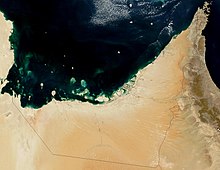
Environmental issues in the United Arab Emirates (UAE) are caused by the exploitation of natural resources, rapid population growth, and high energy demand. The continuing temperature rise caused by global warming contributes to UAE's water scarcity, drought, rising sea level, and aridity. The UAE has a hot desert climate,[1] which is very vulnerable to the effects of climate change and contributes to worsening water scarcity, quality, and water contamination.[2]
The United Arab Emirates is located in the Middle East between Oman and Saudi Arabia, adjoining the Gulf of Oman and the Persian Gulf.[3] In the last years, the impact of global warming on the UAE has intensified the already existing environmental issues, including water scarcity and limited agricultural land.[4] The United Arab Emirates are a contributor to greenhouse gas emissions, listed as having the 29th highest carbon dioxide emissions. Since the boom of the oil industry occurred in the early 21st century, the population and its consumption of energy have sharply increased.
The United Arab Emirates contains the world's seventh largest natural resource of oil and seventeenth-largest natural gas reserve. This possession of a high amount of valuable natural resources pushed the United Arab Emirates to the position of the ninth wealthiest country in the world by 2016 GDP per capita. These financial resources support their adaptation capacity to "climate change-induced challenges".[4] Currently, they are investing in increasing air conditioning infrastructure, rainwater drainage systems, constructing flood barriers and new desalination plants.[4] In June 2016 Abu Dhabi announced a project for an enhanced rainwater drainage system due to unnaturally occurring thunderstorms in March 2016 which caused 860 damages on properties and flooding.[5]
The three main characteristics of United Arab Emirates' politics contribute to the recent natural unsustainability. First, the Emirates feature components of a rentier state; secondly, it is governed by an authoritarian political system; and finally, both facts cause critical natural resource-related trades.[4] In particular, UAE as a rentier state means that the federalization gains external rent from foreign individuals, companies and governments. A rentier state's economy is predominated by the dependency on external rents. Oil revenues also count as external rent.[6]
- ^ Hellyer, Peter (2001). United Arab Emirates: A New Perspective. Bertrams. ISBN 1900724472.
- ^ Tolba, Mostafa K.; Saab, Najib W. (2009). 2009 Report of the Arab Forum for Environment and Development. 2009 Arab Forum for Environment and Development (AFED). ISBN 978-9953-437-28-6.
- ^ "The World Factbook — Central Intelligence Agency". cia.gov. Retrieved 6 November 2016.
- ^ a b c d Cite error: The named reference
:0was invoked but never defined (see the help page). - ^ "Dh39m project to upgrade Abu Dhabi's rainwater drainage system | The National". Retrieved 7 November 2016.
- ^ Hossein, Mahdavy. "The Pattern and Problems of Economic Development in Rentier States: The Case of Iran". Studies in the Economic History of the Middle East.
© MMXXIII Rich X Search. We shall prevail. All rights reserved. Rich X Search
